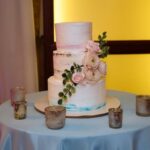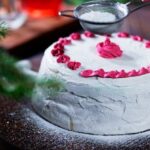Are you looking to elevate your cake decorating skills? Learn how to decorate cake with royal icing to create stunning and intricate designs that will surely impress your friends and family.
Royal icing is a versatile and essential element in the world of cake decorating, allowing for intricate designs, vibrant colors, and impressive textures. In this article, we will explore the significance of royal icing in cake decoration and provide a step-by-step guide on how to use it to create beautiful and professional-looking cakes.
Royal icing is a type of frosting made from egg whites or meringue powder, confectioners’ sugar, and water. It dries to a hard, smooth finish, making it perfect for creating detailed decorations that can last for an extended period. Its importance in cake decorating cannot be overstated, as it allows decorators to create intricate designs such as lacework, flowers, and piping details that are not easily achievable with other types of frosting.
In the following sections, we will discuss the tools and ingredients needed for decorating with royal icing, preparing the cake for royal icing decoration, creating different designs and patterns with royal icing using piping techniques, adding color to royal icing for vibrant designs, and providing tips and tricks for working with royal icing.
Whether you are a beginner or an experienced decorator looking to enhance your skills further, this article will provide valuable insights into mastering the art of decorating cakes with royal icing.
Tools and Ingredients Needed for Decorating With Royal Icing
Decorating cakes with royal icing requires a specific set of tools and ingredients to achieve the best results. The most important tool for decorating with royal icing is a piping bag, which can come in various sizes and materials. A good quality piping tip set is also essential for creating different designs and patterns on the cake. Additionally, a turntable can make the decorating process much easier by allowing you to rotate the cake as you work.
In terms of ingredients, royal icing typically consists of powdered sugar, egg whites or meringue powder, and water. It is important to use fresh, high-quality ingredients to ensure that the royal icing sets properly and holds its shape once piped onto the cake. Gel food coloring can also be used to add vibrant colors to the royal icing, allowing for endless design possibilities.
Other useful tools for working with royal icing include a scribe tool for fixing mistakes or creating fine details, as well as parchment paper or acetate sheets for practicing piping techniques before decorating the actual cake. By having these essential tools and ingredients on hand, you will be well-equipped to start decorating cakes with beautiful royal icing designs.
Preparing the Cake for Royal Icing Decoration
Before you start decorating your cake with royal icing, it is essential to ensure that the cake surface is prepared properly. One important step is to make sure that the cake has been crumb-coated with a thin layer of buttercream or ganache to seal in any loose crumbs. This will provide a smooth base for the royal icing decoration.
Once your cake has been crumb-coated and chilled, it’s time to prepare it for the royal icing decoration. Start by outlining the design you want to create on the cake using a toothpick or food-safe marker. This will serve as a guide when applying the royal icing.
After you have outlined your design, fill a piping bag with stiff consistency royal icing in the desired color. Use a small round tip for outlining and flooding larger areas with icing. Begin by carefully piping along the outline of your design, then fill in the area by flooding it with more royal icing. You can use a toothpick to help spread out the icing evenly and remove any air bubbles.
Successfully preparing your cake for royal icing decoration will set the stage for creating beautiful and intricate designs. Following these steps will ensure that you have a smooth base to work on and that your royal icing decorations will adhere well to your cake surface.
| Step | Description |
|---|---|
| 1 | Crumb-coat the chilled cake. |
| 2 | Outline the design on the cake surface. |
| 3 | Pipe and flood areas with stiff consistency royal icing. |
Creating Different Designs and Patterns With Royal Icing
When it comes to decorating cakes with royal icing, the possibilities are endless. From simple swirls and dots to intricate lace-like designs, royal icing offers a wide range of options for creating beautiful and unique patterns on your cake.
Here are some ideas for creating different designs and patterns with royal icing:
1. Lace Patterns: Use a fine piping tip to create delicate lace patterns on the surface of your cake. You can also use lace molds to make the process easier.
2. Floral Designs: Pipe small flowers or leaves using a flower nail and parchment paper, then let them dry before carefully transferring them to your cake for a beautiful floral pattern.
3. Geometric Shapes: Create modern and clean designs by using royal icing to pipe geometric shapes such as squares, triangles, or hexagons onto your cake.
4. Scrolls and Swirls: Use a curved piping tip to create elegant scrolls and swirls that can add a touch of sophistication to your cake design.
By experimenting with different piping tips, techniques, and stencils, you can unleash your creativity and come up with endless possibilities for decorating your cake with royal icing. Remember that practice makes perfect, so don’t be afraid to try out new designs and patterns until you find the ones that work best for you.
Using Piping Techniques for Intricate Decorations
Choosing the Right Piping Tips
When using royal icing for decorating, it’s important to have the right piping tips on hand. The size and shape of the tip will determine the thickness and design of your lines. For fine details and lines, a small round tip is ideal. If you want to create borders or 3D decorations, a larger star or petal tip may be more suitable.
Mastering Pressure Control
One of the key skills in piping with royal icing is learning how to control pressure. The amount of pressure you apply to the piping bag will determine the thickness of your lines. Practice on parchment paper first to get a feel for how much pressure is needed to achieve different line thicknesses.
Techniques for Intricate Designs
For detailed designs and decorations, it’s important to have a steady hand and a good sense of spacing. You can create intricate lace-like patterns, floral designs, or even elaborate script writing with royal icing. Practice drawing these designs on paper before attempting them on the cake. And always remember that patience is key when working with intricate royal icing designs.
By mastering these piping techniques, you’ll be able to create stunning and intricate decorations that will elevate your cake decorating game. With practice and patience, you can become proficient in using royal icing for all kinds of delicate designs and patterns on your cakes.
Adding Color to Royal Icing for Vibrant Cake Designs
Royal icing is a versatile and popular choice for decorating cakes due to its smooth texture and ability to hold intricate designs. Adding color to royal icing can take your cake decorations to the next level, allowing you to create vibrant and eye-catching designs. There are several methods for adding color to royal icing, each with its own benefits and considerations.
One common method for coloring royal icing is to use gel or paste food coloring. Gel or paste colors are highly concentrated, allowing you to achieve rich and vibrant hues without adding excess liquid to the icing. This helps maintain the consistency of the royal icing, which is crucial for creating crisp lines and intricate details on your cake decorations.
Another popular method for coloring royal icing is using powdered food coloring. Powdered colors can be added directly to the icing, providing a more natural and pastel-like hue compared to gel or paste colors. This method is great for achieving softer tones in your royal icing decorations.
Finally, some decorators prefer to use natural food dyes such as beet juice or turmeric powder to color their royal icing. Natural food dyes offer a chemical-free alternative for adding color to royal icing, perfect for those looking for organic options or special dietary restrictions.
| Coloring Method | Benefits |
|---|---|
| Gel or Paste Food Coloring | Highly concentrated, vibrant colors without adding excess liquid |
| Powdered Food Coloring | Natural and pastel-like hues; suitable for softer tones |
| Natural Food Dyes | Chemical-free alternative; perfect for organic options or special dietary restrictions |
Tips and Tricks for Working With Royal Icing
When working with royal icing, there are several tips and tricks that can help you achieve the perfect cake decorations. These techniques can make the process easier and ensure that your designs come out looking professional and polished.
Consistency Is Key
One of the most important things to keep in mind when working with royal icing is achieving the right consistency. Royal icing can be adjusted to different consistencies depending on the type of design you want. For intricate details, a thicker consistency is needed, while flooding or covering larger areas requires a thinner consistency. It’s essential to master the art of adjusting the consistency of your royal icing to achieve the best results.
Keep Your Tools Clean
Another important tip for working with royal icing is to keep your tools clean at all times. Any stray crumbs or dried icing can ruin a design, so it’s crucial to clean piping tips, couplers, and bags regularly throughout the decorating process. Ensure that your workspace is clean and free from any contaminants that could mar your finished product.
Practice Patience
Working with royal icing can be a delicate process, so it’s important to have patience and take your time. Rushing through a design can lead to mistakes or smudges that are difficult to fix. Take your time and work methodically, especially when creating intricate designs or patterns. Practicing patience will ultimately result in a more polished finished product.
By keeping these tips in mind as you work with royal icing, you’ll be better equipped to create stunning cake decorations that are sure to impress. Remember that practice makes perfect, so don’t be discouraged if your first attempts aren’t flawless – with time and experience, you’ll become more skilled at working with royal icing for all of your cake decorating needs.
Troubleshooting Common Issues When Decorating With Royal Icing
Decorating a cake with royal icing can be a fun and creative process, but it can also come with its challenges. Common issues that may arise when working with royal icing include consistency problems, air bubbles, and bleeding colors.
One of the most common issues encountered when using royal icing is achieving the right consistency. If the icing is too thin, it will not hold its shape and may run off the sides of the cake.
On the other hand, if the icing is too thick, it will be difficult to pipe and may result in an uneven finish. To troubleshoot this issue, it’s important to carefully follow the recipe for royal icing and adjust the consistency by adding small amounts of water or powdered sugar as needed.
Another common problem when decorating with royal icing is the formation of air bubbles in the piping bag. These air bubbles can cause interruptions in the flow of icing and create an uneven surface on the cake. To prevent this issue, slowly squeeze out any air from the piping bag before starting to decorate, and gently tap the bag against a flat surface to release any remaining air bubbles.
Finally, bleeding colors can be a frustrating issue when working with royal icing. This occurs when different colors of icing start to mix or bleed into each other, resulting in an undesirable finish. To troubleshoot this problem, make sure to allow each color of icing to fully dry before adding another color on top. Additionally, using gel food coloring instead of liquid coloring can help prevent bleeding colors.
By being aware of these common issues and knowing how to troubleshoot them, you can become more confident in your royal icing cake decorating skills and create beautifully decorated cakes for any occasion.
Conclusion and Final Tips for Perfecting Your Royal Icing Cake Decorations
In conclusion, decorating cakes with royal icing is a versatile and impressive way to create stunning designs and patterns on your baked creations. By learning the essential tools and techniques, you can elevate your cake decorating skills to the next level. Whether you’re a beginner or an experienced baker, mastering royal icing decoration can open up a world of possibilities for expressing your creativity and wowing your friends and family.
To perfect your royal icing cake decorations, it’s essential to practice patience and precision. Take the time to familiarize yourself with piping techniques and experiment with different designs. Don’t be discouraged by any initial challenges you may encounter – troubleshooting common issues, such as consistency and air bubbles, is all part of the learning process.
Lastly, remember that practice makes perfect. The more you work with royal icing and explore its potential for creating vibrant colors and intricate patterns, the more confident you will become in your cake decorating abilities. So don’t be afraid to challenge yourself and push your creative boundaries – the end result will be worth the effort when you see the delight on people’s faces as they admire your beautifully decorated royal icing cakes.
Frequently Asked Questions
Can I Put Royal Icing Directly on a Cake?
It is possible to put royal icing directly on a cake, but it may not be the most ideal option in terms of taste, texture, and appearance. Royal icing tends to harden quickly, so it’s important to work efficiently when using it for cake decorating.
Additionally, the contrast in textures between royal icing and cake can be unappealing to some individuals.
How Do You Decorate With Royal Icing?
Decorating with royal icing involves using a piping bag or squeeze bottle to apply intricate designs and details onto cakes, cookies, or other pastries. This process requires a steady hand and some level of skill since royal icing dries relatively quickly. Some popular techniques include creating delicate flowers, intricate lace patterns, or personalized messages.
How Do You Cover a Cake With Royal Icing Without Marzipan?
Covering a cake with royal icing without marzipan entails applying a layer of buttercream or ganache as a base for the royal icing. The purpose of this additional layer is to provide a smooth surface for the royal icing to adhere to and also enhances the overall flavor and texture of the finished product.
Once the buttercream or ganache layer is in place, the royal icing can be carefully applied over it to create a flawless finish on the cake.

Welcome to my blog about home and family. This blog is a place where I will share my thoughts, ideas, and experiences related to these important topics. I am a stay-at-home mom with two young children. I hope you enjoy reading it! and may find some helpful tips and ideas that will make your home and family life even better!





